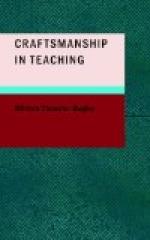Elementary education has often been accused of transacting its business in small coin,—of dealing with and emphasizing trivialities,—and yet every time that the scientific method touches the field of education, it reveals the fundamental significance of little things. Whether the third-grade pupil should memorize the multiplication tables in the form, “8 times 9 equals 72” or simply “8-9’s—72” seems a matter of insignificance in contrast with the larger problems that beset us. And yet scientific investigation tells us clearly and unequivocally that any useless addition to a formula to be memorized increases the time for reducing the formula to memory, and interferes significantly with its recall and application. It may seem a matter of trivial importance whether the pupil increases the subtrahend number or decreases the minuend number when he subtracts digits that involve taking or borrowing; and yet investigation proves that to increase the subtrahend number is by far the simpler process, and eliminates both a source of waste and a source of error, which, in the aggregate, may assume a significance to mental economy that is well worth considering.
In fact, if we are ever to solve the broader, bigger, more attractive problems,—like the problem of vocational education, or the problem of retardation,—we must first find a solution for some of the smaller and seemingly trivial questions of the very existence of which the lay public may be quite unaware, but which you and I know to mean an untold total of waste and inefficiency in the work that we are trying to do.
And one reason why the scientific attitude toward educational problems appeals to me is simply because this attitude carries with it a respect for these seemingly trivial and commonplace problems; for just as the greatest triumph of the teaching art is to get our pupils to see in those things of life that are fleeting and transitory the operation of fundamental and eternal principles, so the glory of the scientific method lies in its power to reveal the significance of the commonplace and to teach us that no slightest detail of our daily work is necessarily devoid of inspiration; that every slightest detail of school method and school management has a meaning and a significance that it is worth our while to ponder.
FOOTNOTES:
[Footnote 12: An address delivered before the St. Louis Society of Pedagogy, April 16, 1910.]
[Footnote 13: Dr. W.T. Harris.]
VIII
THE POSSIBILITY OF TRAINING CHILDREN HOW TO STUDY[14]
I
In its widest aspects, the problem of teaching pupils how to study forms a large part of the larger educational problem. It means, not only teaching them how to read books, and to make the content of books part of their own mental capital, but also, and perhaps far more significantly, teaching them how to draw lessons from their own experiences; not only how to observe and classify and draw conclusions, but also how to evaluate their experience—how to judge whether certain things that they do give adequate or inadequate results.




